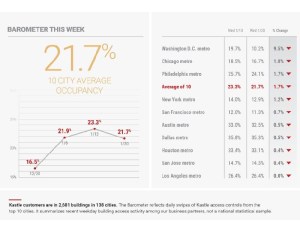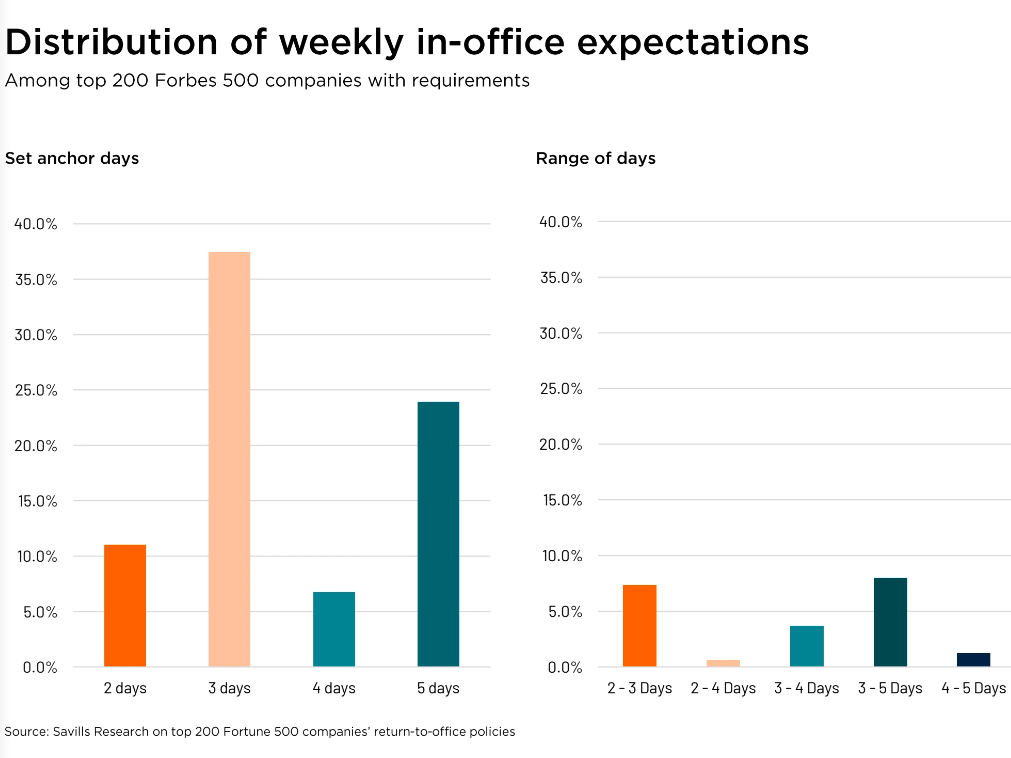Dallas, Houston and Austin Leading Return to Work, Kastle Finds
Kastle Systems’ latest weekly report shows Washington, D.C., is seeing the biggest drop in building occupancy.

Chart courtesy of Kastle Systems
Safety concerns surrounding President Joe Biden’s inauguration, a federal holiday and spikes in COVID-19 cases in parts of the U.S. may have contributed to an average 1.7 percent decline in office occupancy across the nation last week, according to the latest weekly occupancy report from access control firm Kastle Systems.
The Kastle Back to Work Barometer saw building occupancy fall or remain the same last week in the 10 cities measured, resulting in the slight dip to the 10-city average of 21.7 percent, down 1.7 percent from the previous week. With only about 1 in 5 workers in their offices last week, Dallas, Houston and Austin, Texas, continued to lead the nation as the most open cities for office workers.
The report looks at metros for the following areas: Los Angeles; New York; Chicago; Dallas; Washington, D.C.; San Francisco; Houston; Philadelphia; Austin, and San Jose, Calif. The Barometer is an average of the Top 10 cities it serves based on millions of aggregated, anonymous daily building access data points from Kastle-secured properties. To compile it, Kastle Systems uses keycard, fob and KastlePresence app access data from 2,681 buildings in 138 cities.
Not surprisingly, Washington, D.C., had the biggest decline—down 9.5 percent—as much of the city was shut down during the week of the presidential inauguration, when about 25,000 National Guardsmen were deployed to deter any violence similar to the Jan. 6 riot at the Capitol.

Haniel Lynn, CEO, Kastle Systems. Image courtesy of Kastle Systems
“We expected to see a drop in Washington, D.C., due to security concerns around Inauguration Day, but the drops in the other Barometer cities were not entirely unexpected for a number of reasons. Other states were on alert for security concerns, as well, and we were in touch with many of our customers as they worked to prepare that week, in many cases closing down their buildings,” Kastle Systems CEO Haniel Lynn told Commercial Property Executive. “We also think the drop across the board is affected by spikes in (coronavirus) cases resulting in shutdown orders. Finally, while we take out federal holidays, like MLK Day on Jan.18, we know some folks take an extra day or more that week for a longer weekend so that could have an effect on overall occupancy, as well.”
By the numbers
Washington, D.C.’s office occupancy on Jan. 20 was 10.2 percent compared to 19.7 percent the previous Wednesday, Jan. 13. The next biggest percentage drop occurred in the Chicago metro, where office occupancy was 16.7 percent last week, down 1.8 percent from 18.5 percent the previous week.
On Jan. 20, the remaining metros had the following office occupancy figures: Philadelphia, 24.1 percent, down 1.7 percent; New York, 12.9 percent, down 1.2 percent; San Francisco, 11.3 percent, down 0.7 percent; Austin, Texas, 32.5 percent, down 0.5 percent; Dallas, 35.3 percent, down 0.5 percent; Houston, 33.1 percent, down 0.4 percent; San Jose, Calif., 14.3 percent, down 0.4 percent; and Los Angeles, no change at 26.4 percent.







You must be logged in to post a comment.